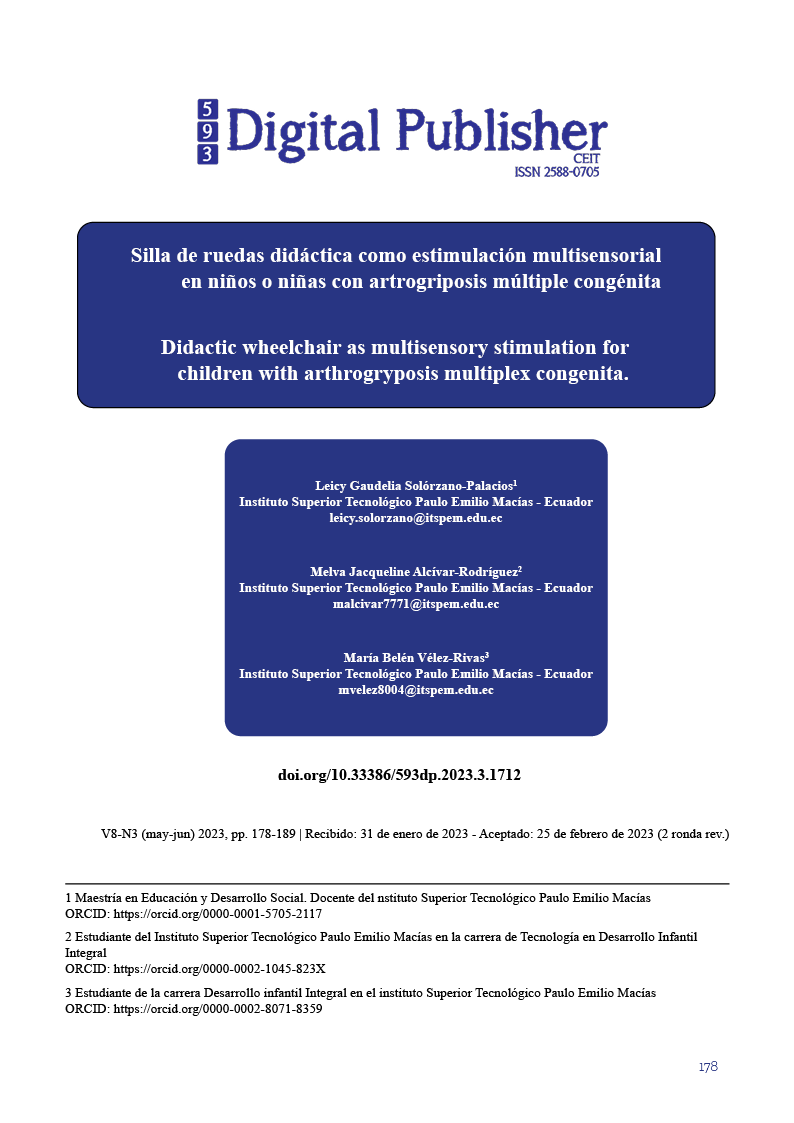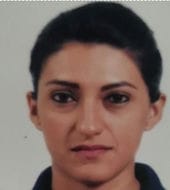Didactic wheelchair as multisensory stimulation for children with arthrogryposis multiplex congenita
Main Article Content
Abstract
This article derives from the research carried out in the work of the project of the didactic wheelchair for multisensory stimulation in boys and girls with arthrogryposis multiplex congenital and thus determine which stimulation is applied in boys and girls and the same benefits in their sensory development. The study to obtain accurate data, an investigation was developed where data was obtained through the research technique which was applied in a precise and analytical manner, this helped to make a more reliable, useful and feasible diagnosis, giving rise to an investigation subject to reality, It is important to make reference that during the investigation it was found that there are no means to provide a better quality of sensory stimulation that parents do not have sufficient resources to obtain a didactic chair and also to attend sensory, motor, , of language and cognitive to what it entails that the boy or the girl does not have adequate stimulation that they need from an early age, which is why a proposal was formulated to create a didactic wheelchair that helps the correct stimulation. sensory of boys and girls with disability caused by arthrogryposis multiplex congenita with in order to help in their sensory, motor, cognitive development and their social relationship, allowing them to be active participants with their environment. In this way, parents and educators are made aware that there are ways and means for them to be part of this stimulation and integral development of the abilities and skills of children.
Downloads
Article Details

This work is licensed under a Creative Commons Attribution-NonCommercial-ShareAlike 4.0 International License.
1. Derechos de autor
Las obras que se publican en 593 Digital Publisher CEIT están sujetas a los siguientes términos:
1.1. 593 Digital Publisher CEIT, conserva los derechos patrimoniales (copyright) de las obras publicadas, favorece y permite la reutilización de las mismas bajo la licencia Licencia Creative Commons 4.0 de Reconocimiento-NoComercial-CompartirIgual 4.0, por lo cual se pueden copiar, usar, difundir, transmitir y exponer públicamente, siempre que:
1.1.a. Se cite la autoría y fuente original de su publicación (revista, editorial, URL).
1.1.b. No se usen para fines comerciales u onerosos.
1.1.c. Se mencione la existencia y especificaciones de esta licencia de uso.
References
Azbell K, D. (2015). Dannemiller L. A Case Report of an Infant with Arthrogryposis. . Pediatr PhysTher, 27(3); 293 - 301.
Barcos, M. (2010). Estimulación Temprana y Neurodesarrollo. Recuperado de http://www.estimulatemprana.com.ar/index.php?s=estimulacion-temprana
Garcia, N. S. (2007). Aplicación Didáctica de Las Actividades de Cinefórum. Claves Para Trabajar en el Aula. Madrid: Vigo.
Gesell, A. (1985). El niño de 1 a 5 años. Paidos Iberica Ediciones S,A.
Gerritsen, J. (2012). Revisión de las investigaciones hechas sobre Estimulación Auditiva Tomatis. 19.
Gomez, M. d. (2009). Aulas de Multisensoriales en la Educaciòn Especial. Madrid: Vigo.
Hall, G. S. (1 de Agosto de 1014). Arthrogryposi. Diagnostic approach to etiology, classification, genetics, and general principles, págs. 464 - 72.
Hill L, T. K. (2012). Effects of Multisensory Environments. Disabil, 25:509–21.
Lexnavarra. (s. f.). Recuperado 7 de diciembre de 2022, de http://www.lexnavarra.navarra.es/detalle.asp?r=10646
López, A., & Paula, M. (2014). “LA INFLUENCIA DE LA ESTIMULACIÓN MULTISENSORIAL EN EL DESARROLLO COGNITIVO DE LOS NIÑOS DE 3 AÑOS QUE ASISTEN A LA UNIDAD PEDAGÓGICA BILINGÜE ENGLISH KIDS”. 130.
Metref, S. y., & Meseguer, C. B. (2007). Jugando se Aprende Mucho: Expresar y descubrir a través del juego. Madrid: Narcea Ediciones.
Ospina Rodríguez, J. (2006). La motivación, motor del aprendizaje. Ciencia de la salud, 158-160.
Richmond, P. G. (2000). P.G. Richmond, Introducción a Piaget, Fundamentos, Madrid 1974, p. 103
Romaguera_DelaCruz_David.pdf. (s. f.-a). Recuperado 7 de diciembre de 2022, de https://dspace.uib.es/xmlui/bitstream/handle/11201/150614/Romaguera_DelaCruz_David.pdf?sequence=1&isAllowed=y
Soler, E. (1992). La Educaciòn Sensorial en la Educaciòn Infantil. Madrid: RIALP, S.A.
Stephenson J, C. M. (2011). Perceptions from Schools. Educ Train Autism. Use of Multisensory Environments in Schools for, 46(2):276–90.




